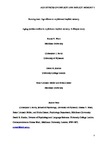Aging Predicts Decline in Explicit and Implicit Memory: A Life-Span Study
| dc.contributor.author | Ward, E | |
| dc.contributor.author | Berry, Christopher | |
| dc.contributor.author | Shanks, D | |
| dc.contributor.author | Moller, P | |
| dc.contributor.author | Czsiser, E | |
| dc.date.accessioned | 2020-04-21T15:40:36Z | |
| dc.date.issued | 2020-07-31 | |
| dc.identifier.issn | 0956-7976 | |
| dc.identifier.issn | 1467-9280 | |
| dc.identifier.other | 0 | |
| dc.identifier.uri | http://hdl.handle.net/10026.1/15582 | |
| dc.description.abstract |
<jats:p> Explicit memory declines with age, but age effects on implicit memory are debated. This issue is important because if implicit memory is age invariant, it may support effective interventions in individuals experiencing memory decline. In this study, we overcame several methodological issues in past research to clarify age effects on implicit memory (priming) and their relationship to explicit memory (recognition, source memory). We (a) recruited a large life-span sample of participants ( N = 1,072) during a residency at the Science Museum in London, (b) employed an implicit task that was unaffected by explicit contamination, and (c) systematically manipulated attention and depth of processing to assess their contribution to age effects. Participants witnessed a succession of overlapping colored objects, attending to one color stream and ignoring the other, and identified masked objects at test before judging whether they were previously attended, unattended, or new. Age significantly predicted decline in both explicit and implicit memory for attended items. </jats:p> | |
| dc.format.extent | 1071-1083 | |
| dc.format.medium | Print-Electronic | |
| dc.language | en | |
| dc.language.iso | en | |
| dc.publisher | SAGE Publications | |
| dc.subject | aging | |
| dc.subject | explicit memory | |
| dc.subject | implicit memory | |
| dc.subject | priming | |
| dc.subject | recognition | |
| dc.subject | open data | |
| dc.title | Aging Predicts Decline in Explicit and Implicit Memory: A Life-Span Study | |
| dc.type | journal-article | |
| dc.type | Journal Article | |
| dc.type | Research Support, Non-U.S. Gov't | |
| plymouth.author-url | https://www.webofscience.com/api/gateway?GWVersion=2&SrcApp=PARTNER_APP&SrcAuth=LinksAMR&KeyUT=WOS:000554531200001&DestLinkType=FullRecord&DestApp=ALL_WOS&UsrCustomerID=11bb513d99f797142bcfeffcc58ea008 | |
| plymouth.issue | 9 | |
| plymouth.volume | 31 | |
| plymouth.publication-status | Published | |
| plymouth.journal | Psychological Science | |
| dc.identifier.doi | 10.1177/0956797620927648 | |
| plymouth.organisational-group | /Plymouth | |
| plymouth.organisational-group | /Plymouth/Faculty of Health | |
| plymouth.organisational-group | /Plymouth/Faculty of Health/School of Psychology | |
| plymouth.organisational-group | /Plymouth/REF 2021 Researchers by UoA | |
| plymouth.organisational-group | /Plymouth/REF 2021 Researchers by UoA/UoA04 Psychology, Psychiatry and Neuroscience | |
| plymouth.organisational-group | /Plymouth/Users by role | |
| plymouth.organisational-group | /Plymouth/Users by role/Academics | |
| dc.publisher.place | United States | |
| dcterms.dateAccepted | 2020-04-13 | |
| dc.rights.embargodate | 2020-5-2 | |
| dc.identifier.eissn | 1467-9280 | |
| dc.rights.embargoperiod | Not known | |
| rioxxterms.versionofrecord | 10.1177/0956797620927648 | |
| rioxxterms.licenseref.uri | http://www.rioxx.net/licenses/all-rights-reserved | |
| rioxxterms.licenseref.startdate | 2020-07-31 | |
| rioxxterms.type | Journal Article/Review | |
| plymouth.funder | Models of Explicit and Implicit Memory: Linking Priming, Recognition, and Source Memory::ESRC |


